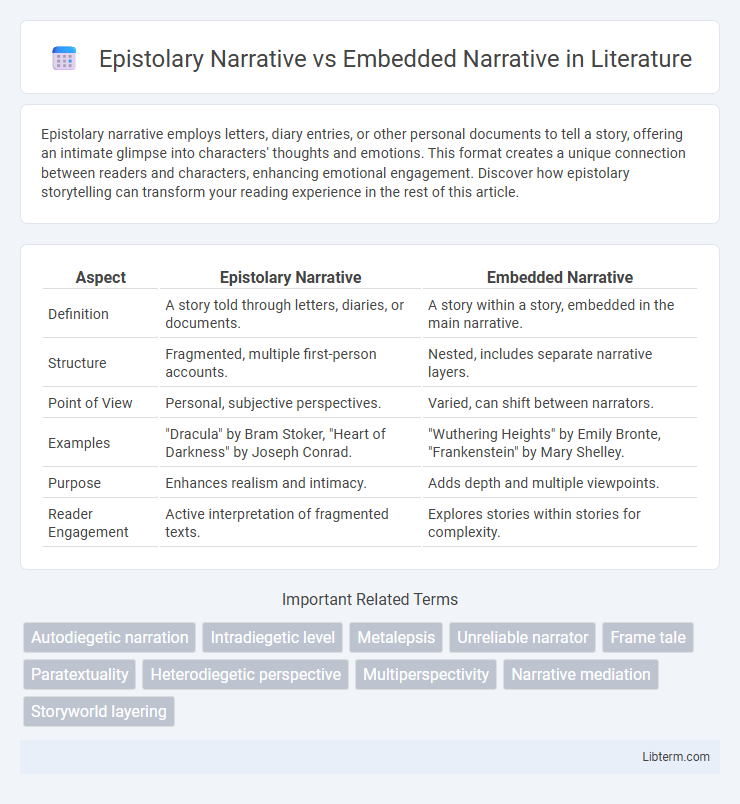Epistolary narrative employs letters, diary entries, or other personal documents to tell a story, offering an intimate glimpse into characters' thoughts and emotions. This format creates a unique connection between readers and characters, enhancing emotional engagement. Discover how epistolary storytelling can transform your reading experience in the rest of this article.
Table of Comparison
| Aspect | Epistolary Narrative | Embedded Narrative |
|---|---|---|
| Definition | A story told through letters, diaries, or documents. | A story within a story, embedded in the main narrative. |
| Structure | Fragmented, multiple first-person accounts. | Nested, includes separate narrative layers. |
| Point of View | Personal, subjective perspectives. | Varied, can shift between narrators. |
| Examples | "Dracula" by Bram Stoker, "Heart of Darkness" by Joseph Conrad. | "Wuthering Heights" by Emily Bronte, "Frankenstein" by Mary Shelley. |
| Purpose | Enhances realism and intimacy. | Adds depth and multiple viewpoints. |
| Reader Engagement | Active interpretation of fragmented texts. | Explores stories within stories for complexity. |
Introduction to Narrative Structures
Epistolary narrative utilizes letters, diary entries, or documents as the primary storytelling method, allowing intimate insights into characters' thoughts and emotions. Embedded narrative, or frame narrative, presents one story within another, creating multiple layers of perspective and enhancing thematic complexity. Both structures shape how readers engage with the plot and character development, influencing narrative reliability and immersion.
Defining Epistolary Narrative
Epistolary narrative is a literary technique where the story is conveyed through a series of documents such as letters, diary entries, or emails, providing intimate insight into characters' thoughts and emotions. This format allows for multiple perspectives and voices, enhancing the authenticity and immediacy of the narrative. Unlike embedded narrative, where a story is nested within another story, epistolary narrative relies solely on personal correspondence to drive the plot forward.
Exploring Embedded Narrative
Embedded narrative interweaves a secondary story within the main plot, enriching thematic depth and character development by offering multiple perspectives. This technique enhances storytelling complexity by layering narratives, allowing readers to uncover connections and contrasts between primary and nested tales. By embedding stories, authors create a dynamic structure that drives engagement and deepens the overall narrative impact.
Historical Evolution of Narrative Techniques
Epistolary narrative, originating in the 17th century, employs letters and diary entries to convey intimate perspectives and personal experiences, deeply influencing the development of subjective storytelling. Embedded narrative, tracing back to classical works like "One Thousand and One Nights," layers stories within stories to create complex, multifaceted plots that enhance thematic depth and character development. The historical evolution of these narrative techniques showcases a shift from straightforward linear storytelling to more intricate structures that reflect psychological realism and narrative multiplicity.
Key Features of Epistolary Narratives
Epistolary narratives are characterized by their structure of storytelling through letters, diary entries, or other personal documents, allowing intimate insight into characters' thoughts and emotions. This format enhances authenticity and immediacy, creating a direct connection between the narrator and reader while often presenting multiple perspectives. Unlike embedded narratives that are stories within stories, epistolary narratives rely on fragmented, first-person accounts that build the plot through subjective, personal communication.
Characteristics of Embedded Narratives
Embedded narratives feature stories presented within the main storyline, often through characters' memories, letters, or oral recounting. These narratives provide deeper context and multiple perspectives, enhancing the complexity and depth of the primary plot. They frequently use a frame narrative structure, allowing the main story to pause while the embedded story unfolds and eventually returns.
Comparative Analysis: Strengths and Weaknesses
Epistolary narrative offers an immersive and intimate perspective through letters or diary entries, enhancing character depth and emotional authenticity but may limit plot complexity and pacing due to its fragmented format. Embedded narrative provides a layered storytelling approach, allowing multiple viewpoints and richer contextual development, yet risks confusing readers with shifts in narrative voices and temporal sequences. The epistolary form excels in personal engagement, while embedded narrative is stronger in structural complexity and thematic exploration.
Impact on Reader Engagement
Epistolary narratives, through letters or diary entries, create intimate and direct connections with readers, fostering empathy and immersion in characters' personal thoughts. Embedded narratives, featuring stories within stories, enhance reader engagement by providing multiple perspectives and deeper context, encouraging active interpretation. Both techniques enrich emotional involvement but differ in immediacy and complexity, shaping how audiences experience the plot and character development.
Notable Works and Examples
Epistolary narratives, characterized by storytelling through letters or diary entries, are exemplified in works like Bram Stoker's *Dracula* and Mary Shelley's *Frankenstein*. Embedded narratives, featuring stories within stories, appear prominently in novels such as Emily Bronte's *Wuthering Heights* and Joseph Conrad's *Heart of Darkness*. These narrative techniques enhance the depth and complexity of literary works by providing multiple perspectives and layers of storytelling.
Choosing the Appropriate Narrative Structure
Selecting between an epistolary narrative and an embedded narrative depends on the desired intimacy and perspective within the story. Epistolary narratives leverage letters or diary entries to provide direct access to characters' personal thoughts and emotions, enhancing authenticity and emotional engagement. Embedded narratives, often presented as stories within stories, allow for complex layering of perspectives, adding depth and context to the main narrative while maintaining structural cohesion.
Epistolary Narrative Infographic

 libterm.com
libterm.com